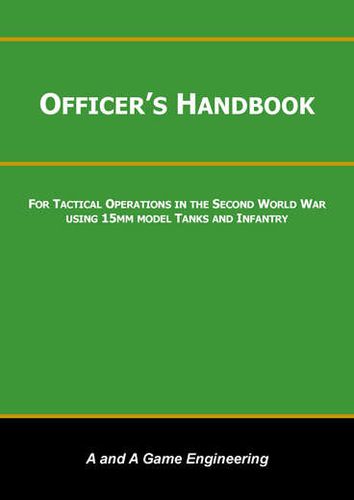|
Advertisement
|
Officer's Handbook: For Tactical Operations in the Second World War Using 15mm Model Tanks and Infantry

DescriptionThese rules provide players with all they require to fight land wargames set in the Second World War involving the major nations involved. We have included France, Germany, Great Britain and the Commonwealth, Italy, Japan, Poland, the Soviet Union, and the United States of America. This decision was influenced by the availability both of models and of reliable source information to help create the game data. We wished to be able to depict the sometimes subtle differences between different national characteristics, particularly regarding Infantry organization and equipment, and differences in both weapons and vehicles. This book contains everything the Player needs to play the game. This means the rules, and the data tables. We decided not to include extensive organization tables or scenarios. There is a wide range of material readily available which Players can use when putting their forces together. Players should feel free to prepare their games using historical formations, for which we provide guidelines about Unit structures, or they can be completely free form with Units put together as the players wish. You should not, however, mix both styles. Historically, armies did use some fairly ad hoc formations such as German Kampfgruppen with various arms of service all mixed together in Units. It was also quite common in the Western Desert for both sides to make use of captured equipment, which would give your games an additional exotic flavour. The basic Units in the game are Platoons of Infantry or Tanks, and Batteries of Artillery. An Armoured Unit consists typically of 3-5 model vehicles; an Infantry Unit has 2, 3 or 4 Bases of Infantry, each representing a Squad; an Artillery Battery usually has 4 Guns, though there could be fewer or more depending on historical practice. It will normally have an Observer and, if it conducts an attack affecting an area, could be Off-table. An Infantry or Cavalry Base represents a squad or troop, based on historic organizations. Some nations have fewer squads making up a platoon, though the individual squads may have larger numbers of men, giving them a better Saving Throw. We do not make use of lower level detail, such as who is actually holding any Special Weapons such as a PIAT or Bazooka. There are a number of important features in this set of rules. The Game Turn does not follow a strictly IGO-UGO method, though Initiative is determined in a traditional fashion. Each Game Turn, the Players get a variable number of Orders which can be assigned to any of their troops. The number available is dependant on the number of Units in action and the effectiveness of their Commanders. A Game Turn is split up into a number of Phases, which alternate between Players. In each Phase a Player can Activate one of his Units and carry out one or more Orders, depending entirely on what the Player wants to do. Each Order is regarded as an Action representing 1 to 3 minutes. When a Player decides that he has taken all the Actions he wishes to with a Unit, play transfers to his opponent, who Activates one of his Units. This means that as the game develops, each Player must choose which enemy threat to react to, and which can be ignored. When a Player has run out of Orders, he can no longer Activate any Units. His opponent continues to use his Orders, and when he has used his last Order the Game Turn ends. This system of alternating Unit Activation means that there are fewer Game Turns, but a large number of Activations and some Units may be able to make sweeping advances across the table (with all the attached risks). Each Order expended is deemed to Fatigue a Unit, making subsequent tasks more difficult. In some cases, Fatigue is in fact just that, physically tiring a Unit. In other cases, such as when firing Ranging Rounds for Artillery, which is not going to tire out the troops particularly, Fatigue represents the effect of time being taken to check on fall of shot, etc. Players must make a decision whether to expend a higher proportion of the available Orders on some Units, at the expense of others. The Fog of War is also present in the form of Contact Markers. These represent the uncertainty surrounding the location of the enemy. These allow the Commanders to keep the location some of their Units uncertain. —description from the publisher Game DiscussionsAdd CommentYou need to be logged in to comment. Insert Bullet List Please enter at least one item. Item: Item: Item: Item: Item: Insert Numeric List Please enter at least one item. Item: Item: Item: Item: Item: Insert Link Please enter the link of the website Optionally you can add display text Insert Email Please enter the email address Optionally add any display text Insert Image Please enter the link of the image Insert YouTube Video Please enter the link of the video Marketplace | ||||

Comments (0)